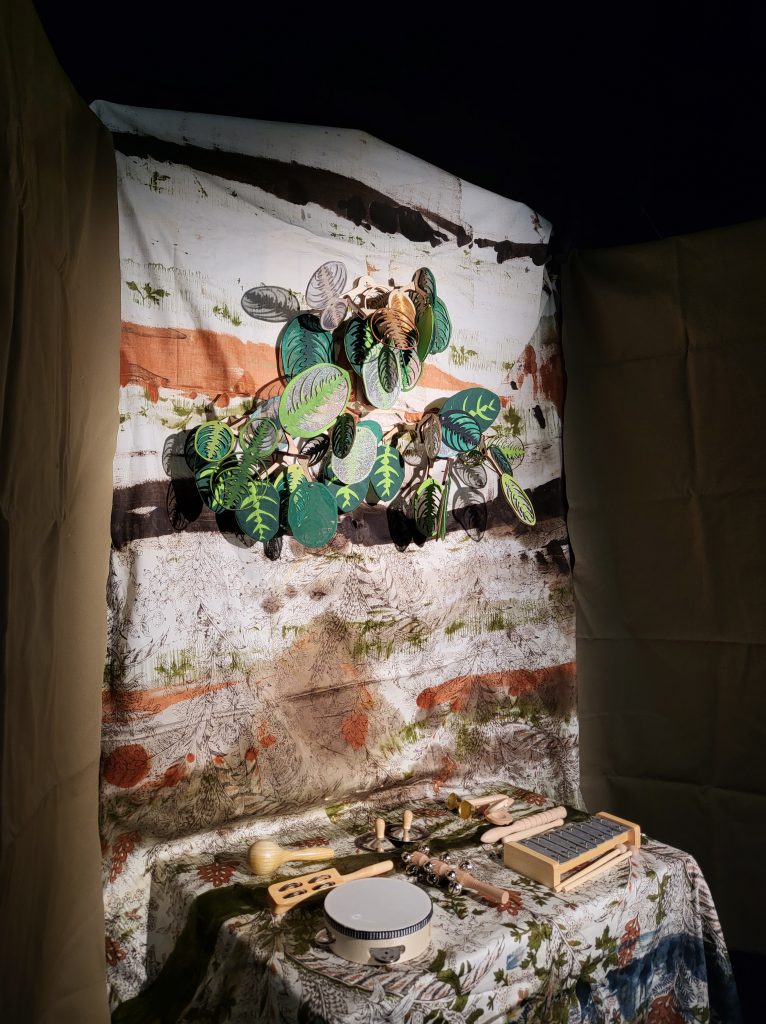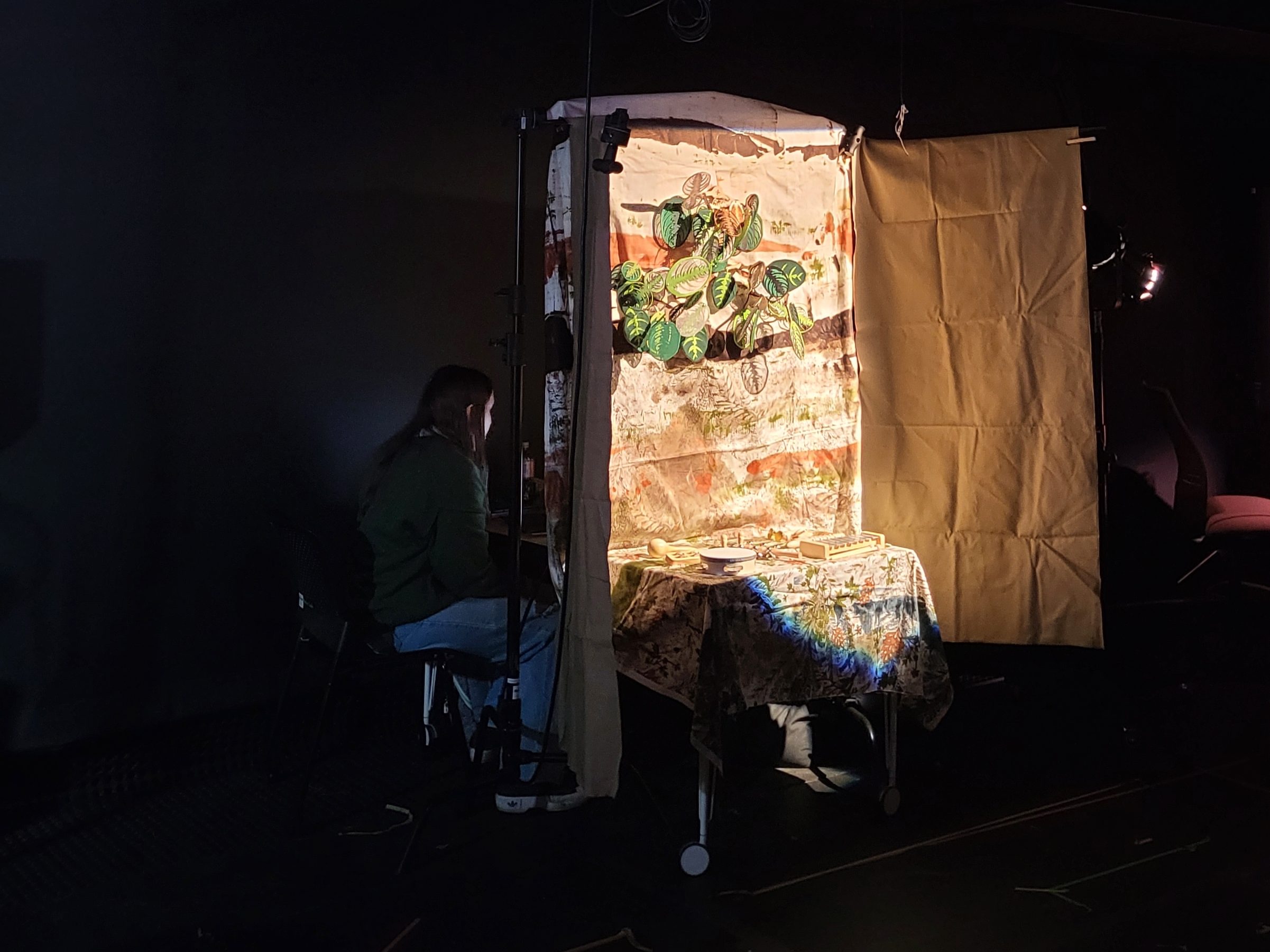Title of Work: Percussion Plant
Project Statement: The purpose of the percussion plant is to represent and simulate the relationship between humans and plants in a more lively and fast-paced manner. Normally the interaction between a plant and a person develops over months as the person gives the plant water, light, and care and the plant slowly grows and moves. The percussion plant responds immediately to sounds created by a variety of instruments by shaking and twisting. The leaves of the percussion plant are modeled off of the prayer plant’s leaves because a prayer plant responds to light by opening up toward it. The percussion plant is meant to act similarly in response to sound.
Relationship of Project to course themes: Our project utilized programmed autonomous behaviors that were played according to the choices that the performer made. The plant robot used three stepper motors that rotated a module with free spinning leaves on the ends. This simple motion created really interesting visual motion and a way for us to create a more animate object. This piece shows how you can utilize robotics and simple movements to put a completely different meaning into a piece. Our plant on its own was already visually interesting, but the motion allows viewers to see a relationship between our actions and plants actions. Just as the prayer plant responds to light and all plants responds to care, our robot plant responds to percussion.

Implementation: To implement our design, we made the branches angled so that the leaves rotate around different axes. We also lasercut wood to cut leaf frames because 3D printing them was time consuming. Attaching fabric and adding color to the leaf frames made it clear that our robot is a plant robot. We also thought about how we could make the audience to make a sound or noise. We came up with an idea that placing percussion toys under the robot would make them want to play with them to see what happens. For our project setup, we decided to make the booth walls angled to semi-hide the performers in the back.




Outcomes: The outcome of our project was an extremely visually interesting piece that was surprisingly interactive. At the show, viewer’s first instinct was to admire the plant and comment on the interesting textures. But once they experimented playing with one of the percussion toys, they found that it also moved. Viewers liked to experiment with different rhythms and instruments to try to find the pattern in the movement. As a performer it was fun to subvert this expectation of pattern by following a certain pattern when it came to consistent sounds but changing it up if it became repetitive. The intent was to make the plant to appear more alive than expected. Some things that could have been improved was the variety of movements from the plant. On show day, there was only a small number of behaviors programmed into the board for the performer to use. This could be expanded to make it even more responsive to different sounds. The way we programmed the plant motions also caused some unexpected behaviors. For example, if buttons were pressed too many times before the blocking movements completed the motions became very delayed. Thus, timing the right movement according to the sound was difficult. Although the program could be refined, the final show still produced pleasant reactions and behaviors from our robot.
Having a main performer and a side performer was also interesting. The main performer, Lauren, found a pattern in which movement to make for different sounds shortly after the show started. When the side performer, Rebecca, and the Lauren were together behind the booth, we both agreed on which movement best suits the sound. However, in one case, Lauren heard the sound as melodical whereas Rebecca thought it was chaotic and loud. Once Lauren said she is thinking about playing the constant movement because she hears a melodical sound, Rebecca could hear it too and agreed to make the robot move constantly.
The audience’s behavior before and after finding out the robot is controlled by a human performer was very different. After the audience found out we were controlling the robot behind the booth, some would play the instruments while looking at us. It was funny to see the audience realize that there are people behind the booth listening to them the whole time.
Performance Video:
Citations:
Stepper motor drive system: https://courses.ideate.cmu.edu/16-375/f2022/ref/text/hardware/cnc-shield.html#id9
Arduino Firmware: https://courses.ideate.cmu.edu/16-375/f2022/ref/text/code/StepperWinch.html#stepperwinch
Base python code edited for project: https://courses.ideate.cmu.edu/16-375/f2022/ref/text/code/suitcase-scripting.html#suitcase-midi-demo-py
Supporting technical documentation:
Lauren’s contributions: Created sewn leaves. Set up electronics and programmed the plant robot.
Rebecca’s contributions: Design and create wood and ABS leaf frames, and attach fabric. Design and lasercut branches and stepper motor mount.